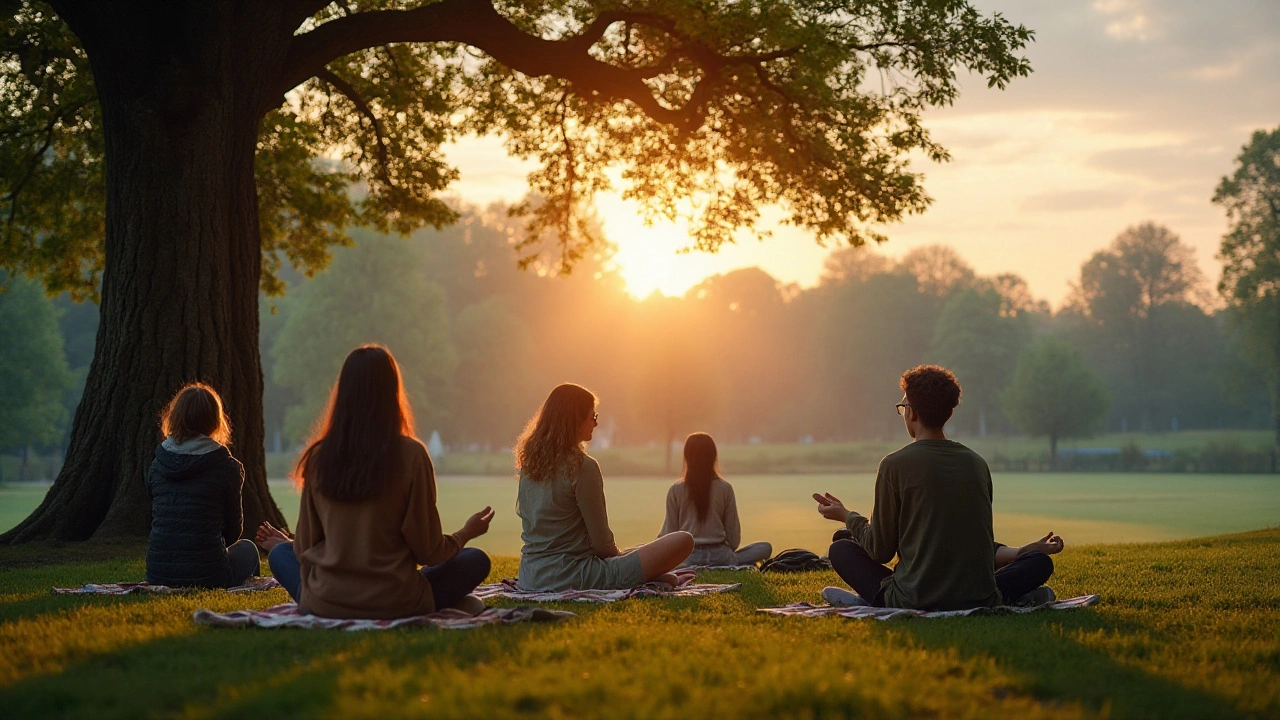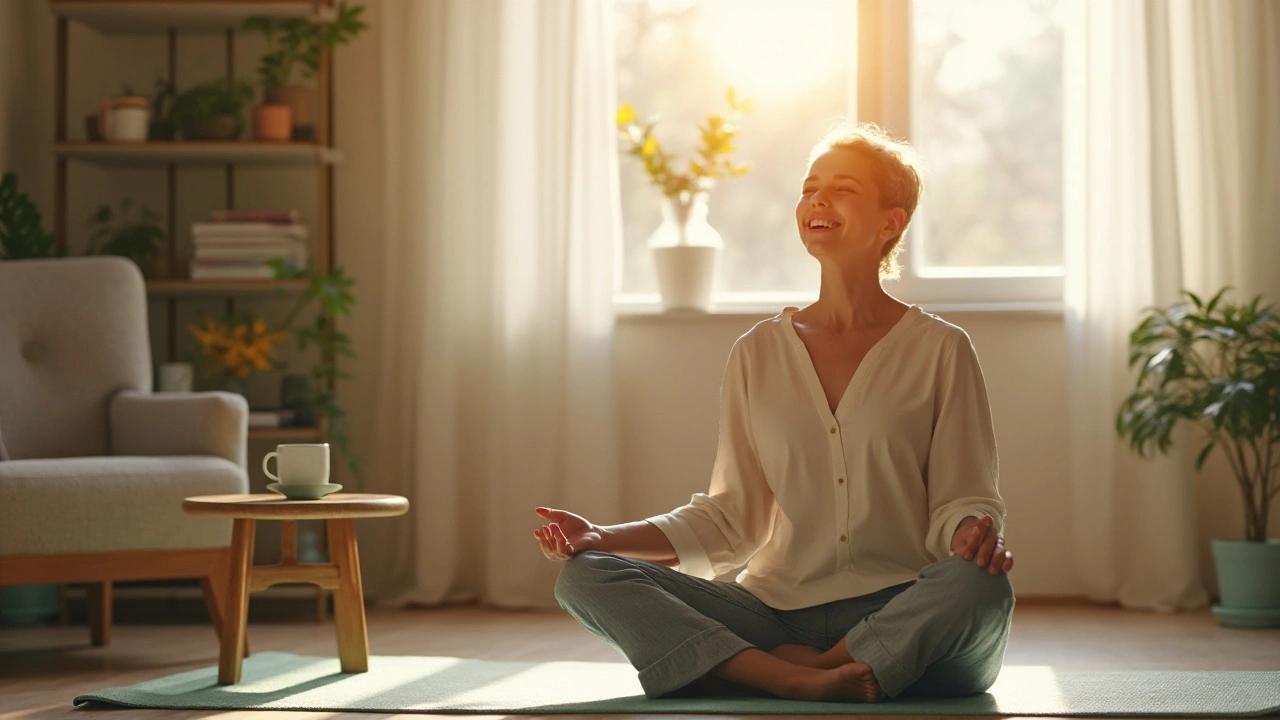Are you curious about mindfulness but not sure where to start? This guide is designed to help you easily begin your mindfulness journey. Whether you're looking to reduce stress, improve your focus, or simply find a bit of calm in your busy day, mindfulness can be a wonderful tool.
Mindfulness is more than just a buzzword; it's a way of being present and fully engaged in the moment. By practicing mindfulness, you can create a sense of peace and clarity that can benefit every aspect of your life.
In this article, we'll explore the basics of mindfulness, delve into some of its key benefits, and provide simple techniques to help you get started. You'll also find tips on incorporating mindfulness into your daily routine and advice on overcoming common challenges. By the end, you'll be equipped with all you need to embark on this transformative journey.
- Introduction to Mindfulness
- Benefits of Mindfulness
- Simple Techniques to Get Started
- Incorporating Mindfulness into Daily Life
- Overcoming Common Challenges
- Additional Resources
Introduction to Mindfulness
Mindfulness has become a bit of a buzzword lately, but its roots go back thousands of years. Originating from ancient Eastern traditions, particularly Buddhism, mindfulness has been practiced as a way to connect more deeply with the present moment. Today, millions of people worldwide embrace mindfulness as a powerful method to foster mental well-being and enhance quality of life.
At its core, mindfulness is the practice of purposely focusing your attention on the present moment—and accepting it without judgment. Jon Kabat-Zinn, a pioneer in bringing mindfulness to the West, describes it as “paying attention in a particular way: on purpose, in the present moment, and non-judgmentally.” By honing this kind of attention, we can cultivate a more fine-tuned awareness and appreciation for everyday experiences.
There are various techniques to practice mindfulness, all of which center around being fully present. One simple approach is mindful breathing. This involves sitting quietly and focusing on your breath. Pay attention to the sensation of air moving in and out of your body. If your mind starts to wander—as it naturally will—gently bring your focus back to your breath. This exercise can be done anywhere and only takes a few minutes, making it an excellent way to start your mindfulness journey.
Research has shown that regular mindfulness practice can have numerous benefits. It can help reduce stress, improve focus, and enhance emotional regulation. According to a study published in the journal 'Mindfulness,' participants who engaged in an eight-week mindfulness program showed significant reductions in perceived stress levels and improvements in psychological well-being.
“The present moment is filled with joy and happiness. If you are attentive, you will see it,” noted Thich Nhat Hanh, a Vietnamese Buddhist monk renowned for his teachings on mindfulness.
Mindfulness is not just about meditation; it can be integrated into everyday activities. For instance, you can practice mindful eating by paying full attention to the taste, texture, and aroma of your food. By savoring each bite, you’re not only cultivating mindfulness but also fostering a healthier relationship with eating. Similarly, mindful walking, where you focus on the sensations of each step, can transform a routine activity into a meditative experience.
So, why has mindfulness become so popular in the modern world? One reason is the increasing awareness of mental health and the need for effective, non-pharmacological interventions to cope with the stresses of daily life. In our fast-paced society, taking the time to pause and be present offers a refreshing counterbalance. Mindfulness invites us to slow down, embrace the moment, and find peace amidst the chaos.
Starting with mindfulness doesn’t require any special equipment or extensive training. All it takes is a willingness to be present and a bit of practice. Whether you’re looking to reduce anxiety, manage stress, or simply improve your overall well-being, mindfulness can be a valuable addition to your daily routine.
Benefits of Mindfulness
Mindfulness offers a myriad of benefits that can transform your life in significant ways. It helps you stay connected to the present moment, and this simple practice can lead to profound changes in your mental and physical well-being. One of the key benefits is stress relief. Regularly practicing mindfulness helps reduce cortisol levels, the hormone responsible for stress. When your cortisol levels are in check, you'll notice a significant reduction in stress and anxiety, making your day-to-day life more manageable.
Another remarkable benefit of mindfulness is its ability to improve your focus. In our fast-paced world, our attention is constantly being pulled in multiple directions. Mindfulness helps in training your brain to stay focused on one task at a time. This not only enhances your productivity but also the quality of your work. Imagine being fully present during a work meeting or while reading a book. The benefits extend to better decision-making and problem-solving skills as well.
Mindfulness is also known for its positive effects on physical health. A regular practice can help lower blood pressure, improve sleep, and even aid in pain management. By being in tune with your body, you can more effectively notice and respond to its needs, whether that means getting more rest or addressing health concerns early on. Studies have shown that mindfulness can boost your immune system, making you more resilient to illnesses.
Jon Kabat-Zinn, the creator of the Mindfulness-Based Stress Reduction program, once said, "Mindfulness means paying attention in a particular way; on purpose, in the present moment, and non-judgmentally."
Emotional regulation is another area where mindfulness shows significant benefits. By becoming more aware of your emotions, you can better understand and manage them. This leads to healthier relationships and a greater sense of joy and contentment in your life. Emotional intelligence is something that can be nurtured through mindfulness, and this skill is invaluable in both personal and professional settings.
Mindfulness can also foster a deeper sense of connection with others. When you are present in your interactions, you listen more intently and respond more thoughtfully. This improved communication can strengthen your relationships, making them more fulfilling and empathetic. The sense of community and belonging that comes from mindful interactions can also improve your overall mental health.
The benefits of mindfulness are not restricted to adults; children can also greatly benefit from it. Introducing mindfulness practices to children can help them manage stress, improve focus, and enhance their emotional intelligence. It's a valuable skill that can set them up for a more balanced and happy life.
All these benefits make mindfulness an invaluable practice for anyone looking to improve their quality of life. Whether you're seeking to reduce stress, improve your focus, or enhance your physical health, mindfulness offers a simple yet effective way to achieve these goals. By dedicating just a few minutes a day to being present, you can experience significant improvements in your overall well-being.

Simple Techniques to Get Started
Starting your journey into mindfulness doesn't have to be overwhelming. There are several simple techniques that can help ease you into the practice. One of the easiest ways to begin is through mindful breathing. This technique involves taking slow, deep breaths and paying attention to the sensation of the breath entering and leaving your body. Find a quiet spot, sit comfortably, and close your eyes if that feels right. Start by inhaling deeply through your nose, then exhale slowly through your mouth. Repeat this process, focusing solely on your breath.
Another effective method is guided meditation. Many apps and online resources offer free guided sessions tailored for beginners. These sessions can range from five minutes to half an hour, making it easy to fit mindfulness into your schedule. During these sessions, a narrator will guide you through the process, helping you focus your mind and relax your body. This can be especially helpful if you find it difficult to meditate on your own.
Body scan meditation is another technique to consider. This practice involves mentally scanning your body from head to toe, paying attention to any areas of tension or discomfort. By doing so, you become more aware of how stress affects your body and can learn to release tension. To start, lie down in a comfortable position and close your eyes. Begin at your toes and slowly move up your body, checking in with each part along the way. Pay attention to how each area feels, and allow yourself to release any stress you find.
Mindful walking is perfect if you prefer a more active approach. This technique involves walking slowly and deliberately, focusing on each step you take. Feel the ground beneath your feet, notice the sensation of your muscles working, and take in your surroundings. Whether you're in a park, your neighborhood, or even indoors, mindful walking can be a simple yet powerful way to practice mindfulness.
Another tip for beginners is to keep a mindfulness journal. Writing in a journal can help you reflect on your mindfulness journey and track your progress. Dedicate a few minutes each day to jot down your thoughts, feelings, and any challenges you faced during your practice. Over time, you'll likely notice patterns and growth, which can be incredibly motivating.
Meditation and mindfulness exercises aren't the only ways to integrate mindfulness into your life. Simple daily activities like eating can also become mindful practices. When you eat, try to do so without distractions like TV or your phone. Pay attention to the flavors, textures, and smells of your food. Eating mindfully can help you appreciate your meals more and may even promote healthier eating habits.
Cornell University researchers found that mindfulness can significantly reduce psychological stress and improve overall well-being. Their studies show the potential of simple mindfulness techniques in achieving these benefits.
If you're struggling to stick with your practice, don't be too hard on yourself. It's normal for your mind to wander or for you to face challenges when starting something new. The key is to be patient and gentle with yourself. Remember, mindfulness is not about perfection but about being present and aware. Consider setting a specific time each day for your practice, making it a part of your daily routine. Consistency can make a big difference in how quickly you see the benefits.
In summary, mindful breathing, guided meditation, body scan meditation, mindful walking, and keeping a mindfulness journal are all effective techniques for beginners. By incorporating these practices into your life, you can begin to experience the profound benefits of mindfulness. Take it one step at a time, and enjoy the journey.
Incorporating Mindfulness into Daily Life
Mindfulness isn't restricted to a special corner of your room or a specific time of day. Integrating mindfulness into your daily life can be seamless and rewarding. One way to do this is by transforming routine activities into moments of mindfulness. For instance, when you brush your teeth, pay attention to the sensation of the toothbrush against your teeth and gums, the taste of the toothpaste, and the feeling of fresh breath afterward. This kind of simple shift in awareness can make a world of difference.
Similarly, eating is another perfect time to practice mindfulness. Try to savor your meals without distractions. Focus on the taste, texture, and aroma of your food. By doing this, not only do you enjoy your meal more, but you also aid better digestion and reduce overeating, a problem many faces today. Take a moment to appreciate where the food comes from and the effort put into preparing it.
Walking offers another opportunity to integrate mindfulness. Whether you're walking to work or taking a stroll in the park, be present in the moment. Feel the ground beneath your feet, notice the rhythm of your breathing, and pay attention to the sounds around you. Walking mindfully helps reduce stress and brings a sense of peace. This practice can be particularly helpful in busy areas to keep you grounded and calm.
Work can be stressful, but incorporating mindfulness practices into your workday can help counterbalance this. Before starting a new task, take a few deep breaths and set a clear intention for what you want to achieve. Use mindful breaks throughout the day to recharge. Even just a minute of focusing on your breath can help you refocus and improve productivity.
"Mindfulness is not about being calm all the time. It is about building resilience to life's challenges." — Jon Kabat-Zinn
Eager to bring mindfulness into your home life? Start with household chores. Washing dishes, for example, is an everyday activity that can be turned into a mindful practice. Feel the warm water and the texture of the soap bubbles. Notice the reflections on the clean dishes. This seemingly mundane task can become a meditative experience, bringing joy and satisfaction to what is often seen as a tedious chore.
Technology can be a significant distraction, but it can also be used to enhance mindfulness. Set reminders on your phone to take mindfulness breaks. Use apps designed for mindfulness and meditation, which offer guided practices to suit different needs. However, it is essential to disconnect from digital devices regularly. Turn off notifications and create screen-free times to lessen the constant bombardment of information and become more present.
Remember, incorporating mindfulness into your daily routine doesn’t have to be time-consuming. Small, consistent practices add up over time, building a foundation of mindfulness that becomes a natural part of your daily life. The key is to be intentional and make minor adjustments to your normal activities. In this way, mindfulness becomes an integrated, enriching part of your existence.

Overcoming Common Challenges
Starting a new practice like mindfulness can be incredibly rewarding, yet many people find they encounter several obstacles along the way. Some challenges may be external, such as a lack of time, while others are internal, like a wandering mind. Understanding these challenges and knowing how to address them can make a significant difference in maintaining a consistent mindfulness routine.
One of the most common hurdles people face is the feeling of having 'no time' for mindfulness. The modern world moves quickly, making it easy to feel as though we can’t spare even a few minutes daily. However, carving out time for meditation and mindfulness does not have to be a daunting task. Start small, with just five minutes each day, and gradually increase the time as you become more comfortable. These short moments of mindfulness can add up, creating a profound impact on your life.
Another frequent challenge is dealing with a restless or wandering mind. It's very normal for your mind to drift, especially when you're just starting. The key is to gently bring your focus back to your breathing or the present moment without judging yourself. Over time, you'll find it easier to maintain focus, but remember that it's okay to have days where your mind is all over the place. Consistency and patience are essential elements of a successful mindfulness practice.
Maintaining motivation can also be a significant obstacle. Without immediate, dramatic results, you might question the effectiveness of mindfulness. Bear in mind that mindfulness is a gradual process, and the benefits often become more apparent over time. Keeping a journal can help track your progress and serve as a motivating factor. Additionally, joining a mindfulness group, whether in-person or online, can provide a sense of community and accountability.
Some people might find that physical discomfort becomes a barrier. Sitting still for extended periods can be challenging. To address this, experiment with different postures until you find one that feels comfortable for you. You might also try mindful walking as an alternative to seated meditation. The important thing is to remain engaged in the practice, regardless of physical constraints.
Another common pitfall is the expectation of perfection. Mindfulness is not about achieving a perfect state of calm; it’s about being present and accepting the moment as it is. Let go of the need for perfect meditation sessions and allow yourself to experience whatever comes up. Remember, even seasoned practitioners have days where their mindfulness practice is less than ideal. The important thing is to show up consistently.
As Jon Kabat-Zinn, a pioneer of mindfulness, once said, "You can’t stop the waves, but you can learn to surf." This perfectly encapsulates the essence of mindfulness—it's not about controlling your thoughts but learning to navigate them calmly.
Lastly, some people may hesitate to start mindfulness practices due to misconceptions about what it involves. Mindfulness isn't about emptying your mind or becoming a different person; it's about paying attention to your experience in a non-judgmental way. This simple shift in perspective can lead to profound changes in how you handle stress and relate to others.
Tackling these challenges with patience and persistence can pave the way for a fulfilling mindfulness practice. Over time, you may find that mindfulness becomes not only easier but an indispensable part of your daily life.
Additional Resources
Diving into mindfulness can feel overwhelming at first, but having the right resources can make the journey smoother. Here are a few resources to help you ease into your practice and make mindfulness a lasting habit. These include books, apps, podcasts, and online communities.
**Books** are a wonderful way to deepen your understanding of mindfulness. One highly recommended read is "The Miracle of Mindfulness" by Thich Nhat Hanh, a Zen master who has helped popularize mindfulness in the West. His simple yet profound teachings can be a great starting point. Another must-read is "Wherever You Go, There You Are" by Jon Kabat-Zinn, the founder of Mindfulness-Based Stress Reduction (MBSR). His practical advice and easy-to-understand writing make the book a favorite among beginners.
**Apps** have revolutionized the way we practice mindfulness and meditation. Apps like “Headspace” and “Calm” offer guided meditations tailored for beginners. They also feature sleep stories, breathing exercises, and mindful walking sessions. Another fantastic app is “Insight Timer,” which not only offers thousands of free guided meditations but also allows you to join live sessions and connect with other meditators worldwide.
If you prefer listening, **podcasts** can be an excellent resource. “The Mindful Kind” by Rachael Kable covers various aspects of mindfulness in daily life, from dealing with stress to improving relationships. Another great listen is “On Being” hosted by Krista Tippett. Though it covers various topics, episodes often delve into themes around mindfulness and meditation, providing a broader perspective on the practice.
**Online communities** can offer support and encouragement as you start your mindfulness journey. Websites like Reddit have dedicated forums where members share tips, experiences, and resources. Participating in an online community can make you feel less alone and more motivated.
Finally, don't underestimate the value of **local classes and workshops**. Many community centers and yoga studios offer mindfulness workshops. These in-person sessions provide an opportunity to ask questions and get feedback directly from experienced practitioners. Some places may even offer free introductory classes.
"Mindfulness isn’t difficult; we just need to remember to do it." - Sharon Salzberg
Remember, the best approach to starting mindfulness is simply to begin. Look into these resources and see what resonates with you. Experiment with different methods and tools, and soon you'll find a routine that fits your lifestyle and needs.






